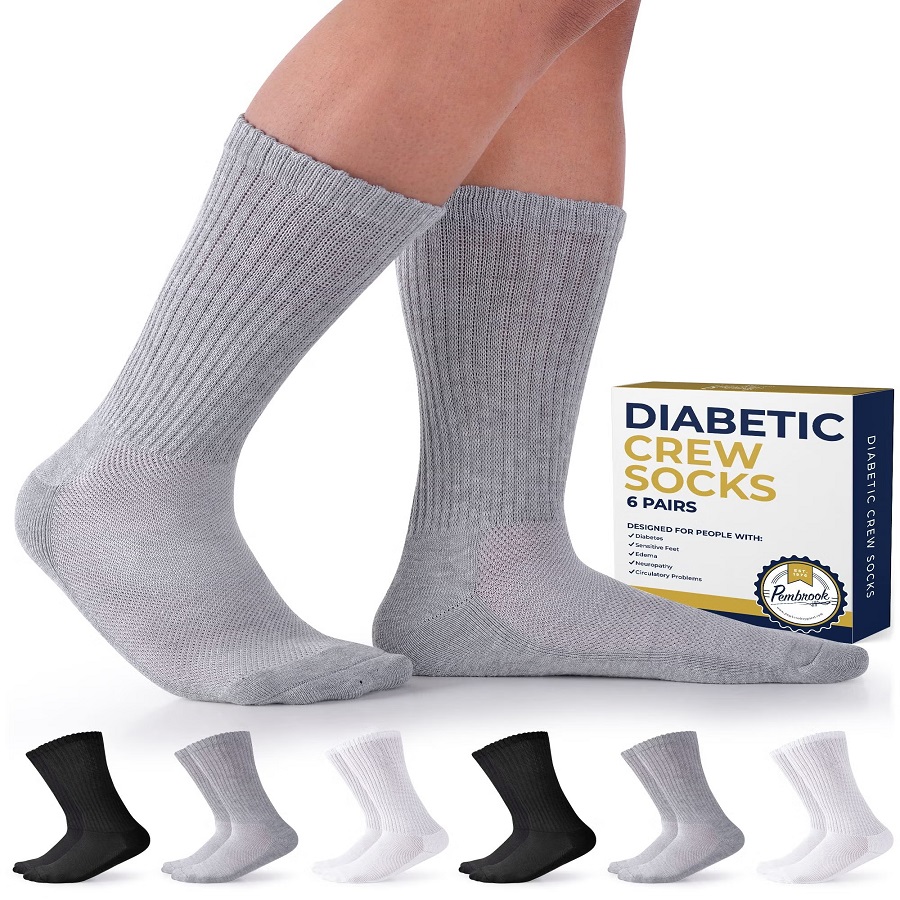Understanding Neuropathy and Its Symptoms
Neuropathy affects the nervous system, causing a variety of symptoms. People with this condition often feel numbness in their limbs. Tingling sensations are also common. Some patients report sharp, stabbing pains. Others may experience a loss of balance or coordination. In severe cases, muscle weakness can occur. It can make daily tasks difficult. This is why proper management is crucial.
Neuropathy has many causes. It can stem from diabetes, injury, or even certain medications. The type of neuropathy dictates the symptoms and treatment options. It is important to know the symptoms. This helps you seek timely medical advice. Doctors can guide treatment, including the use of compression socks for neuropathy.
Compression socks apply pressure to the legs. This can improve blood flow and reduce discomfort. For neuropathy sufferers, they can ease symptoms and improve quality of life. Knowing these symptoms is the first step to managing the condition effectively.
The Role of Compression Socks in Neuropathic Care
Compression socks are key in managing neuropathy symptoms. These socks provide steady pressure to the legs. This pressure boosts circulation. Better blood flow aids in reducing numbness and tingling. It can also help ease the sharp pains common in neuropathy. By improving circulation, compression socks for neuropathy support nerve health. Good circulation is vital for nerve function. It brings nutrients and oxygen to the nerves. This can help slow down the progression of neuropathy.
When wearing compression socks, the consistent pressure can limit swelling. This is particularly helpful for those with diabetes. Swelling is a common issue in diabetic neuropathy. It can lead to further complications. Compression socks keep this in check. They fit snugly and should be comfortable to wear. Remember to choose the right size for the best benefits.
For those with balance issues, these socks can provide a sense of stability. The support around the legs can improve proprioception. This is the body’s ability to sense its position. Better awareness can translate to improved balance and coordination. It is a simple change that can make daily tasks easier.
In summary, compression socks for neuropathy play a vital role. They manage symptoms and enhance nerve health. They also provide stability and comfort. This helps neuropathy sufferers live better, more active lives.

Types of Compression Socks Suitable for Neuropathy Patients
Not all compression socks are the same. They differ in style, fit, and pressure levels. When you have neuropathy, choosing the right type is key. Here are some options.
- Gradient Compression Socks: These apply different pressure levels at various points. The most pressure is at the ankle. It decreases up the leg. This design is good for improving blood flow.
- Anti-Embolism Socks: These are for people who are less active. They help with blood flow when you are sitting or lying down for a long time.
- Non-medical Support Hosiery: These offer uniform pressure. They are milder in compression. You can buy them without a prescription. They may suit mild neuropathy symptoms.
When choosing compression socks for neuropathy, consider these factors. Look for socks with moisture-wicking material. This keeps your feet dry. Avoid seams that might rub against your skin. Socks should fit well but not be too tight.
It’s important to speak with a healthcare professional. They can recommend the best type and fit for your condition. Wearing the right compression socks for neuropathy can help manage your symptoms. It makes your daily life more comfortable.
How to Properly Use Compression Socks for Neuropathy
Proper use of compression socks for neuropathy ensures maximum relief. It’s key to follow a few simple steps. Begin with choosing the right size. Socks should feel snug but not too tight. Carefully roll the socks up your legs each morning. Doing so when you rise optimizes blood flow throughout the day. Ensure that no wrinkles form. Wrinkles can cause discomfort or skin issues.
Consult a healthcare professional before use. They will help pick the right compression level. Follow their guidance on how many hours to wear the socks each day. Some may wear them all day while others only during activity. Take off the socks before bedtime unless advised otherwise.
Keep your skin clean and dry. This will help reduce the risk of any skin irritation. Inspect your feet and legs regularly for signs of pressure marks or skin damage. If such signs appear, consult your healthcare professional.
Wear them consistently for the best results. Make them a part of your daily neuropathy management routine. Over time, regular use can help ease neuropathy symptoms. Remember, compression socks for neuropathy are a tool in your overall care plan.
Benefits of Using Compression Socks for Neuropathy Relief
Compression socks for neuropathy can provide numerous benefits. Here are some key advantages:
- Alleviate Pain and Discomfort: By improving blood flow, these socks can reduce the pain and discomfort often associated with neuropathy.
- Decrease Swelling: Compression socks gently squeeze the legs, which can help reduce swelling and inflammation.
- Enhance Circulation: Enhanced circulation from the socks delivers more oxygen and nutrients to nerve cells, aiding in their function and possibly slowing disease progression.
- Improve Mobility: With better balance and stability, users may find an improvement in their overall mobility.
- Minimize the Risk of Further Injury: Good blood flow can protect against injuries by maintaining healthier skin and nerve tissues.
- Better Quality of Life: Wearing compression socks can make day-to-day activities more comfortable, enhancing the wearer’s quality of life.
Remember to consult with healthcare professionals to find the most suitable compression socks for your needs. While these benefits are promising, it’s important to incorporate them as part of a comprehensive neuropathy management plan.

Potential Side Effects and Precautions When Using Compression Socks
While compression socks for neuropathy can bring relief, users should be aware of potential side effects. It’s rare, but some individuals may experience skin irritation or discomfort. If socks are too tight, they could cut off circulation. This would defeat their purpose and might lead to new issues. In rare cases, people have allergic reactions to the material of the socks. As a safety measure, always check your skin for changes. Look for redness, itching, or swelling. If you see any, stop using the socks and talk to your healthcare provider.
Be cautious not to wear socks that are too long. They should not bunch up. This can cause pressure sores. Always choose the right size and compression level for your body. A healthcare professional can help with this. They know about compression socks for neuropathy. Make sure to follow their advice.
Also, keep your nails trimmed and skin moisturized. This prevents scratches and dry skin. Such precautions help avoid complications. Watch for signs of poor circulation too. Cold toes or a blue tint to the skin are warning signs. If you notice these, seek medical help fast.
Remember, compression socks are one part of neuropathy care. They should fit well into your wider health plan. Use them as directed for the best results and minimal risks.
Choosing the Right Compression Level for Your Needs
Choosing the right level of compression in your socks is vital for neuropathy care. Compression levels are measured in millimeters of mercury (mmHg). They indicate the amount of pressure the socks will exert on your legs. Here’s a simple guide to help you select the right compression level for your neuropathy needs:
- Mild Compression (8-15 mmHg): Ideal for those who have mild discomfort. These can provide relief without being too restrictive. They are great for everyday wear.
- Moderate Compression (15-20 mmHg): Good for moderate to severe symptoms. This range can help with more pronounced pain and swelling.
- Firm Compression (20-30 mmHg): Often recommended for individuals with severe neuropathy symptoms. Seek medical advice before opting for this level.
- Extra Firm Compression (30-40 mmHg): These are used in serious conditions. It is advised to use them under a doctor’s supervision.
The right compression level depends on your specific condition. It also suits your lifestyle and activities. When you discuss your symptoms with a healthcare professional, they can suggest the best option for you. It’s all about finding a balance. The socks should provide enough pressure to manage symptoms without causing discomfort or circulation problems. Take note, a healthcare provider’s recommendation is crucial. It ensures you get the therapeutic benefits while minimizing any risks. Wearing the right compression socks for neuropathy can make a significant difference in your comfort and can play a significant role in managing the condition.

Incorporating Compression Socks into Your Daily Neuropathy Management Routine
Incorporating compression socks for neuropathy into your daily routine is a smart choice. These socks can provide you with ongoing relief and improve your daily living. Here are simple steps to get started:
- Wear Compression Socks Each Morning: Put them on first thing in the morning. This maximizes their effect on blood flow throughout the day.
- Match Socks with Your Activity Level: Choose compression levels that fit your daily activities. For a sedentary day, mild compression may suffice. For more active days, moderate to firm compression might be needed.
- Consult Healthcare Professionals Regularly: They can monitor your condition. They will adjust your compression level as needed.
- Inspect Your Legs and Feet Daily: Look for any signs of irritation or pressure marks. Report any problems to your healthcare provider immediately.
- Care for Your Compression Socks: Wash them as directed to maintain their elasticity and compression level.
By following these simple guidelines, compression socks for neuropathy can be an effective part of your overall health routine. They help not just with symptom management but also in preventing potential complications. Don’t forget, they work best in combination with other treatment options prescribed by your healthcare professional.









